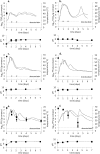Composting for avian influenza virus elimination
- PMID: 22389376
- PMCID: PMC3346479
- DOI: 10.1128/AEM.07947-11
Composting for avian influenza virus elimination
Abstract
Effective sanitization is important in viral epizootic outbreaks to avoid further spread of the pathogen. This study examined thermal inactivation as a sanitizing treatment for manure inoculated with highly pathogenic avian influenza virus H7N1 and bacteriophages MS2 and 6. Rapid inactivation of highly pathogenic avian influenza virus H7N1 was achieved at both mesophilic (35°C) and thermophilic (45 and 55°C) temperatures. Similar inactivation rates were observed for bacteriophage 6, while bacteriophage MS2 proved too thermoresistant to be considered a valuable indicator organism for avian influenza virus during thermal treatments. Guidelines for treatment of litter in the event of emergency composting can be formulated based on the inactivation rates obtained in the study.
Figures

References
-
- Adams MH. 1959. Bacteriophages. Interscience Publishers, Inc, New York, NY
-
- Adcock NJ, et al. 2009. The use of bacteriophages of the family Cystoviridae as surrogates for H5N1 highly pathogenic avian influenza viruses in persistence and inactivation studies. J. Environ. Sci. Health A Tox. Hazard Subst. Environ. Eng. 44:1362–1366 - PubMed
-
- Bendfeldt ES, Peer RW, Flory GA. 2006. In-house composting as a rapid response to avian influenza. BioCycle 47:38
-
- Blumel J, Schmidt I, Willkommen H, Lower J. 2002. Inactivation of parvovirus B19 during pasteurization of human serum albumin. Transfusion 42:1011–1018 - PubMed
-
- Böhm R, Hunsinger B, Mardare C, Nagler C. 2008. Behaviour of prion-proteins in anaerobic and aerobic treatment of animal by-products, p 379–381 In Koutev V. (ed), 13th RAMIRAN International Conference—potential for simple technology solutions in organic manure management Network on Recycling of Agricultural Municipal and Industrial Residues in Agriculture (RAMIRAN), Albena, Bulgaria
Publication types
MeSH terms
Substances
LinkOut - more resources
Full Text Sources
Other Literature Sources

